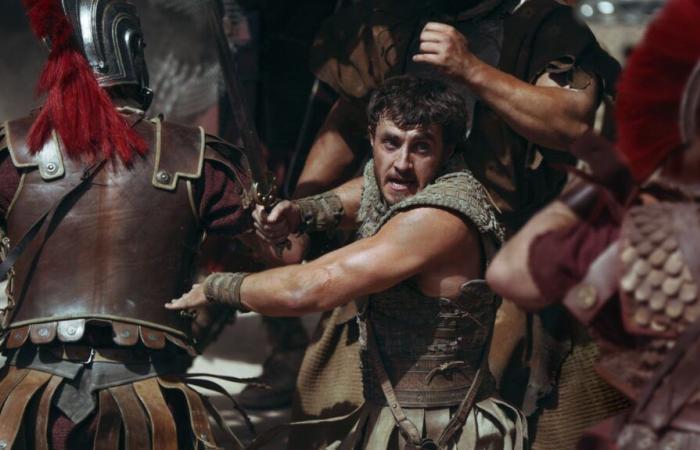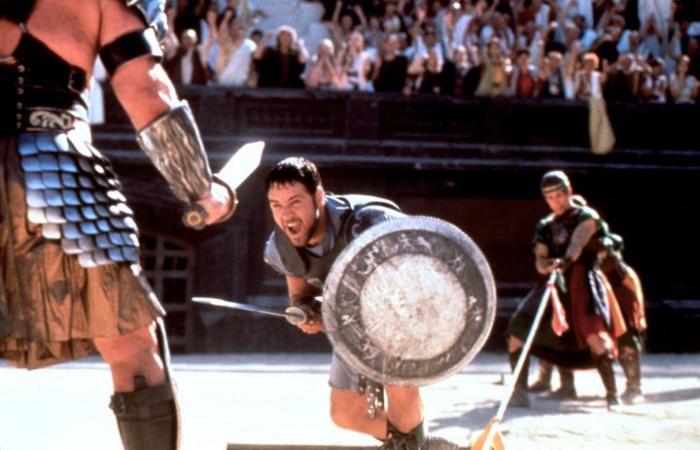With its gladiator films, the American “dream machine” has forged a mythology where it is more about the Vietnam War or the intervention in Iraq more than the Roman Empire.
“Aren’t you full? Haven’t you had enough fun?” Maximus shouts to the crowd in one of the memorable scenes of Gladiatorreleased in 2000. We must believe not, because the continuation of the story of the fallen Roman general, who was nicknamed “The Spaniard” in the arena, is released in theaters on Wednesday November 13. Russell Crowe and Joaquin Phoenix gave way to Paul Mescal and Denzel Washington, but director Ridley Scott did not put his camera away. And it promises spectacle, spectacle and more spectacle. With, in the background, a political reflection on the era, the trademark of the peplum since its appropriation by Hollywood.
The canons of the genre were forged during the golden age of the peplum, between 1945 and 1965 – the decline of large-scale skirted spectacle films being linked for specialists to the aptly named The Fall of the Roman Empirewith Sophia Loren and Alec Guinness headlining.
Rule n°1: we only speak very vaguely about Antiquity. “Look at the prologue added at the beginning of Where Are You Going (1951) which establishes a parallel between Nero, persecutor of Christians, and the Nazis”supports the American historian Martin M. Winkler, author of numerous books on the representation of this period on the big screen. Another blockbuster of the decade, The Ten Commandments open with a monologue explaining that the story that follows tells “the birth of freedom”contrasting the servants of God and those enslaved to Pharaoh Ramses. “Are men the property of the State or of souls liberated under the aegis of God? The battle continues even today.” The tone is set.
Rule n°2: if the Roman Empire can be used to embody Nazi Germany, the totalitarian USSR or the dark side of the United States, persecuted Christians always symbolize Americans. “At this time, the Romans are immediately identified as villains by the viewer, just like the Nazis”illustrates Martin M. Winkler. “No wonder they are played by British actors, when the characters who stand against tyranny like Moses, Ben-Hur or Spartacus are played by American actors, like Charlton Heston and Kirk Douglas”supports peplum specialist Michel Eloy.
Rule #3: Look at the release date of the film, you will inevitably know what it is about. Take Where are you going? (1951). “A country under the yoke of a tyrant, Nero, who abused the cult of personality, for the viewer of the time, the reference to Stalin is obvious”supports film critic Laurent Aknin. A big decade later, The Fall of the Roman Empire concludes with a lesson in realpolitik stated by an old senator, demonstrating that alternatives to war are preferable… received by contemporary spectators of the Vietnam War.
This monologue was taken up as is by Francis Ford Coppola in his recent Megalopolisportrait of a futuristic New York where the codes and decorum of ancient Rome prevail. The director of Godfather andApocalypse Now made no secret of having filmed a necessarily political epic, just before the presidential election in his country: “Today America is Romehe describes to the press at the Cannes Film Festival. She’s about to have the same experience, for the same reasons that Rome lost its Republic and ended up with an Emperor.”
After decades of lean cows, this is the first Gladiator (in 2000) which gives a boost to the skirt and sandals genre. The formula is not revolutionary: a scenario modeled on The Fall of the Roman Empirecelebratory images of Emperor Commodus reminiscent of Nazi scenographies and the inevitable contemporary message. “The screenwriters insist throughout the film that sports stars can be much more influential than an American president”, summarizes the historian Robin Lane Fox in the Financial Times.
Message which finds its climax in a scene: the reconstruction of the battle of Carthage on the sand of the Colosseum, where the gladiators led by Maximus are supposed to be cut to pieces by the Roman legion. “The host introduces this sequence of circus games with the phrase: ‘Let’s go back to sacred Antiquity’points Laurent Aknin. It’s very ‘meta’. We know that we are witnessing a reconstruction, necessarily distorted, of a show.” Moreover, this time, it was not the Romans who won, to the great dismay of Commodus, who blurted out from the stands: “My knowledge of history is a little vague Cassius, but wasn’t it the barbarians who lost the battle?”
The surprise success of Ridley Scott’s film did not lead to a string of films depicting the turpitudes of the Roman Empire – unlike the success of Spartacus by Stanley Kubrick, followed by a jam of around forty gladiator films between 1961 and 1964. Because September 11 occurred shortly after. Out of the question of playing Brutus by sticking a knife in the back of Caesar (in other words the United States).
Spectators are asking for more Antiquity: they will be treated to Greek mythology from every angle. Without politics being put in the closet like Troyby Wolfgang Petersen, where a motley coalition besieges a city in the middle of the desert under a false pretext during an interminable siege. Any resemblance to the scenario of the second Iraq war would not be purely coincidental.
“I can’t believe it”is surprised by the director, who had the impression of seeing his rushes on the news every evening after filming, in the New York Times. “Nothing has changed in 3,000 years!” How not to interpret the very graphic George W. Bush years 300 by Zack Snyder, in which a handful of Spartans find themselves surrounded by darker-skinned Persians, or the Prince of Persiaa blockbuster blockbuster by Jerry Bruckheimer, where the city of Alamut is combed for weapons of mass destruction… which don’t exist?
The peplum ultimately became a very… American genre, like the western, “as if the connection between the spectacular and the political awaited the mass media of a modern Empire to take on its full extent.”describes the academic Vivien Bessières in her essay on the deterritorialization of the peplum. “In addition to the United States, only one country really has a tradition of this type: Italy”points out critic Laurent Aknin.
In the Boot, Cinecitta plays it more classic. We just note a marked prevalence of mythological subjects compared to American production. The plasticity of the genre with respect to the era translates differently than in America: under Mussolini, the industry even produced fascist peplums like Scipio Africanus – released at the time when the Duce set its sights on Ethiopia in 1937. And when Christian democracy, hegemonic after the war, lost ground in 1964, the genre practically disappeared in favor of the western (spaghetti, of course).
It is almost as much at the ballot box as in the Hollywood studios that the future of the peplum is being played out. “Donald Trump’s victory could revive interest in films on Christian subjects”believes Laurent Aknin, recalling that there already exists a market for biblical films, but which does not go beyond American borders. Historian Martin Winkler decides: “The peplum has proven for decades that it is the ultimate political seismograph.”







